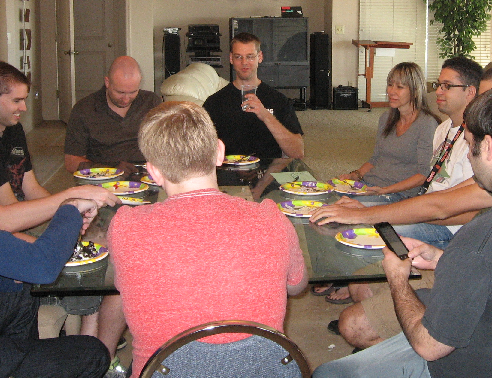Successful social anxiety therapy groups follow the guidelines established by years of consistent research about social anxiety. While individual appointments can help a person make progress with cognitive therapy, a group of people is needed to help people make behavioral progress.
Successful social anxiety therapy groups:
1. Are composed ONLY of people with a diagnosable case of social anxiety disorder.
2. Run by an experienced group leader who understands how to move people ahead in the appropriate manner.
3. Has specific, written instructions for each new cognitive strategy.

For example, one of the first strategies we introduce to new patients, individually or in a group, is the idea (theme) that anxiety must be slowed down. This is an important theme that must be reinforced by many specific cognitive strategies. We start out with a strategy that is practical and can be used in people's daily lives. This first "slowing down" strategy is called "Slow Talk" or "Calm Talk," which is the refusal to let anxiety get you worked up, nervous, and rushed. Slowing down the anxiety allows rationality and calmness to take over.
4. Each specific cognitive strategy should be thoroughly explained, and the rationale should be clear as to why it is used, and what effect this has on daily, every day life.
5. Strategies must be reinforced and repeated. Group members must want to overcome social anxiety, and be willing to spend about thirty minutes a day learning the cognitive strategies. Once a strategy is learned, there must be encouragement to use the strategy in the group.
For example, once "slow talk" is thoroughly understood and learned, people volunteer to use slow talk when they mingle with others, read a passage from a book, or answer questions from other group members. Slowing down is an important element in getting control over anxiety because, physiologically, anxiety is an excess amount of adrenaline and cortisol running through the system. Several specific cognitive strategies should be focused on specific ways that people can slow down this response to anxiety. One of our handouts is titled "Responding to Anxiety in a New Way" and it goes into detail about what to do and why to do it when a person is in the middle of an anxious situation. Many specific cognitive strategies should be learned and used by people so that they can get in control of their anxiety and slow it down.
 6. As members volunteer to put the strategies into place, they should do it in a systematic way only. We call it the "step by step" approach and quite literally use this idea in our groups. A person is never forced or pressured to do something. They volunteer to do an activity, while using one or two of the cognitive strategies.
6. As members volunteer to put the strategies into place, they should do it in a systematic way only. We call it the "step by step" approach and quite literally use this idea in our groups. A person is never forced or pressured to do something. They volunteer to do an activity, while using one or two of the cognitive strategies.
7. People volunteer for what they can do (e.g., reading in front of the group, talking about something non-important in front of the group, making small talk conversation with other group members).
8. People volunteer to do something if it causes them a little anxiety - but no more than this. I do not let any of my groups members volunteer to do something that is "too much," or too far, too fast. If flooding is allowed, then people will be reinforcing their anxieties. As a result, anxiety grows stronger.
9. People are motivated and encouraged by the group leader, but not forced to do anything. The group leaders should be positive-minded and rationally proactive. Small things, like tone of voice and intentions are highly important to the group's success.
10. Everyone should have some personal time to work on reducing anxiety in situations in which the group can serve as the audience.
For example, people who fear speaking in front of others gradually begin to work toward this point. The first step may be in reading something while sitting down. Then, the person may ask the group to ask them questions while sitting down. Then, at some point, they feel comfortable in coming to the front of the room and reading or answering questions. As anxiety continues to be reduced, they may choose to present something minor to the group. As time progresses, they systematically move forward, doing a little bit more each week, and present a little more information each time.
11. Group activities must be thoroughly explained. Everyone must understand the rationale behind the group activity. No suprises should be allowed at this stage. Group members should always know the direction the group is going in and what some group members may choose to do.
 For example, one group activity we do, called the "Circle of Death," is going around the circle introducing ourselves and telling a little bit about ourselves. Before ever starting this activity, a long explanation is necessary; the group leader should be very calm and clear as s/he spells it all out, so the person can see that this is not, as they thought before, the "end of the world." People who experience just a tiny amount of anxiety are OK to go ahead and do this activity, but if anyone is flooded with anxiety after the explanation, then they should NOT participate in the activity until their anxiety has been calmned down. The group leader should split up the parts of the activity, doing one, then another, then the third part of the activity so that it makes it easier for everyone to begin. I always ask permission of my group members before we start an activity as a group, because they must be ready - and experiencing just a small amount of anxiety - for us to move forward, do it, and be rational with ourselves afterwards.
For example, one group activity we do, called the "Circle of Death," is going around the circle introducing ourselves and telling a little bit about ourselves. Before ever starting this activity, a long explanation is necessary; the group leader should be very calm and clear as s/he spells it all out, so the person can see that this is not, as they thought before, the "end of the world." People who experience just a tiny amount of anxiety are OK to go ahead and do this activity, but if anyone is flooded with anxiety after the explanation, then they should NOT participate in the activity until their anxiety has been calmned down. The group leader should split up the parts of the activity, doing one, then another, then the third part of the activity so that it makes it easier for everyone to begin. I always ask permission of my group members before we start an activity as a group, because they must be ready - and experiencing just a small amount of anxiety - for us to move forward, do it, and be rational with ourselves afterwards.
12. The group leader must become comfortable in guiding, steering, and encouraging people to do what they need to do to overcome social anxiety.
13. You can tell if you're working on something in the group that will permanently decrease your anxiety by using this rule:
If what you're doing causes a little self-consciousness, or
if it causes a little discomfort because you're the center of attention,
then you are on the right track.
14. The step by step process for each individual must be maintained. People take one step at a time and that's it. Trying to combine steps to make faster progress doesn't work and causes the person to have a setback. We never want to reinforce setbacks, discouragements, and high levels of anxiety.
15. As each specific cognitive strategy is practiced, learned, and implemented in the group, it should be talked about in terms of "proactivity." Group members can report back to the group each week what they did during the previous week in taking a cognitive strategy and putting it into place in their lives. The focus is on getting better - never on complaining about our anxiety problems.
16. In a social anxiety group, everyone else understands what social anxiety does to lives, and they intuitevely understand each other's situations in life. Group members can become great "therapists" themselves as they meet with the group, outside of the official therapy time, and help each other with the specific cognitive strategies. Group members who help other group members produce a double positive effect: they reinforce what they're learning for themselves, and they help another person to reinforce the strategy they need to learn thoroughly.
17. Group members should be encouraged to meet together, hang out, and go places with each other during the other six days of the week. To overcome social anxiety, you have to learn to feel more comfortable around other people, and the best approach to doing this is in working with other people who have social anxiety. Hanging out and going places keeps the members busy instead of alone, depressed, and lonely. This way allows support seven days of the week.
These are simply some of the things group leaders and group members should know. We will continue on this theme in future posts.
Specific Cognitive Strategies That Reduce Anxiety
What is Comprehensive Cognitive-Behavioral Therapy for Social Anxiety Disorder?
A Short History of the Audio Series "Overcoming Social Anxiety: Step by Step"
